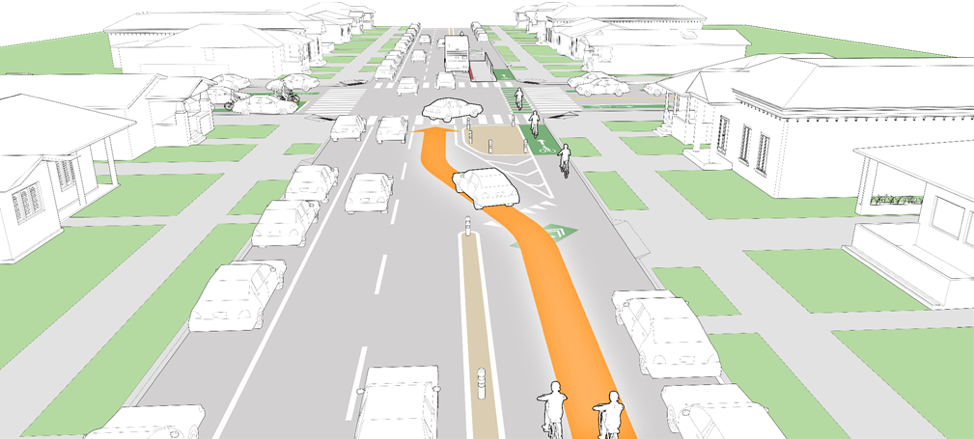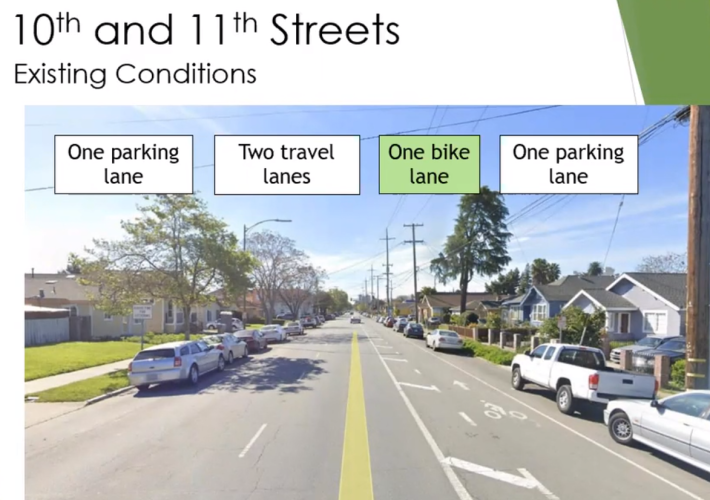San Jose’s Innovative Bike and Frontage Lane Plan
4:35 PM PDT on September 16, 2020

A rendering of a new design from San Jose’s DOT.
A busy, three lane, fast moving, one-way street. Driveway after driveway in a single-family neighborhood. Not enough money to build a curb-height, raised-and-protected bike lane. And not a situation where any standard bike lane treatment will do, if the goal is to make biking safe and comfortable for people of all ages and abilities.
"We had to find a different way," explained Ramses Madou with San Jose's Department of Transportation, of a project for 10th and 11th Street in San Jose. Madou said he and other officials met with NACTO and planners throughout the country, and came up with an innovative solution: if it's politically infeasible to transform the whole street, transform one lane.
The result is now the plan for 1.5 miles on each of the two streets. Installation will begin later this year or early next.
From a project summary on the design:
Tenth and Eleventh Streets currently have two travel lanes, one bike lane, and parking on both sides of a one-way street. This project proposes a design that keeps the two travel lanes and two curbside parking lanes, and makes changes to the bike lane and intersections. A concrete curb will be added to the outside of the bike lane, including at driveways. Local traffic accessing the parking and driveways would enter the bike lane at the beginning of each block, and exit at the end of the block. This new bike lane is a “frontage lane” for local access only.
Madou explained to Streetsblog that the neighbors like the idea, because it means a calmer lane right in front of their houses and they keep all their on-street parking. The design will make it impossible for through traffic to continue in the frontage lane, so the right lane will become a miniature "slow street." Given there are only about ten houses per block, that means it'll be accessed by a handful of cars and delivery vehicles all day long, making for a calm and enjoyable experience for cyclists.

But what's really innovative is San Jose is incorporating protected intersections into the design. Also from SJDOT:
At intersections, the project will install concrete islands near the corners that serve several purposes. These concrete islands would slow turning vehicles, creating safer crossings for pedestrians and bicycle users. They would also help guide vehicle access to the frontage lane and driveways. Lastly, at bus stops, the concrete islands would serve as a location to wait for and board the bus.
Madou explained this is very different than a typical frontage lane, such as the one on Octavia in San Francisco, where motorists can continue directly across intersections. Instead, it will be banned with concrete: entrances and exists to the frontage lane "Will only be 5 or 6 feet wide," said Madou. So perfect for cyclist, but for motorists "unless you’re driving a tiny old Honda Civic you’re not going to fit."
There will be mixing zones, as seen in the lead image, but there should be so few cars using the frontage road that conflicts between motorists and cyclists will be rare. There's also no actual travel lane reduction, so home owners have no reason to object and the politics should be easier (so far at least). A local politician told Madou that it feels as if "we’re solving so many problems with this design."
As with other forward-thinking San Jose bike lane projects, this installation is piggy backing on scheduled repaving. A paint-and-bollard proof-of-concept will be installed in the next three to six months, that will include temporary dividers.

The project, including 14 transit boarding islands, will cost $1.7 million.
Assuming all goes well, a fully built-out and beefed up concrete island or concrete barrier version will go in the following year. But before that, on Oct. 6 of this year, the San Jose City Council will take a final vote on the Better Bike Plan 2025, a plan to build "a network of citywide low-stress bikeways (sometimes called “all-ages and abilities” bikeways). The bikeways network will consist of about 400 miles of separated bikeways on busier streets and about 100 miles of bike boulevards on calmer neighborhood streets." The 10th and 11th Streets project is just a small part of what San Jose hopes to accomplish, transitioning from a car-based city to one where people can safely and quickly get around by transit and bike.
Read More:
Stay in touch
Sign up for our free newsletter
More from Streetsblog San Francisco
SFMTA Starts West Portal Outreach
Agency presents plans to block traffic from crossing in front of the train station




